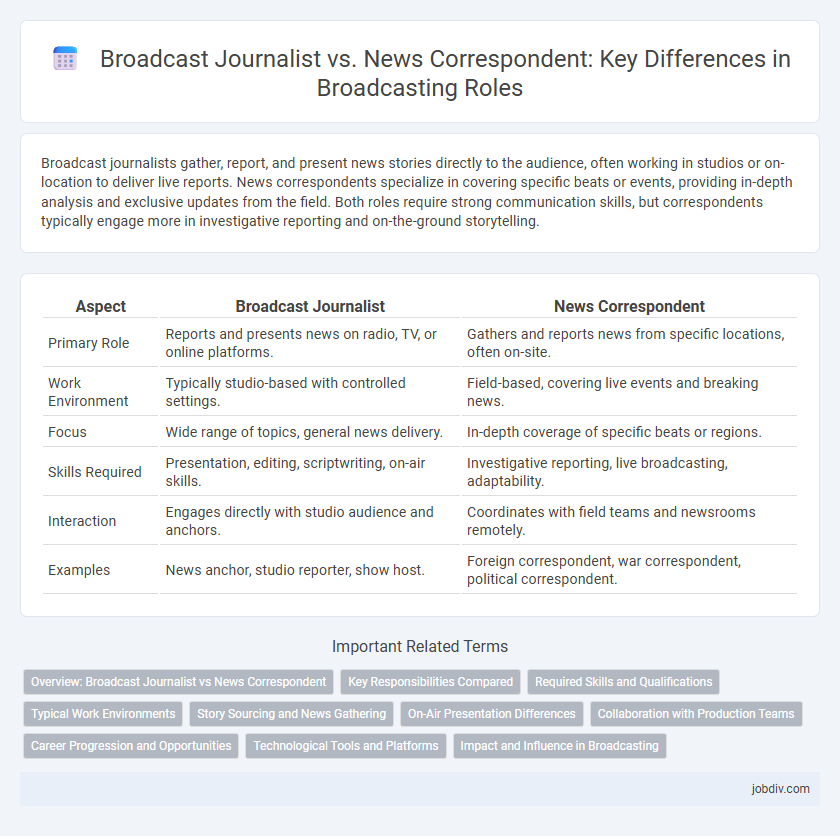Broadcast journalists gather, report, and present news stories directly to the audience, often working in studios or on-location to deliver live reports. News correspondents specialize in covering specific beats or events, providing in-depth analysis and exclusive updates from the field. Both roles require strong communication skills, but correspondents typically engage more in investigative reporting and on-the-ground storytelling.
Table of Comparison
| Aspect | Broadcast Journalist | News Correspondent |
|---|---|---|
| Primary Role | Reports and presents news on radio, TV, or online platforms. | Gathers and reports news from specific locations, often on-site. |
| Work Environment | Typically studio-based with controlled settings. | Field-based, covering live events and breaking news. |
| Focus | Wide range of topics, general news delivery. | In-depth coverage of specific beats or regions. |
| Skills Required | Presentation, editing, scriptwriting, on-air skills. | Investigative reporting, live broadcasting, adaptability. |
| Interaction | Engages directly with studio audience and anchors. | Coordinates with field teams and newsrooms remotely. |
| Examples | News anchor, studio reporter, show host. | Foreign correspondent, war correspondent, political correspondent. |
Overview: Broadcast Journalist vs News Correspondent
Broadcast journalists gather, write, and present news stories for television, radio, and online platforms, often working in studios or on location to deliver timely reports. News correspondents specialize in reporting from the field, providing in-depth coverage and live updates on specific events or beats for major news organizations. Both roles require strong journalistic skills, but broadcast journalists tend to have a broader scope, while correspondents focus on detailed, on-the-ground reporting.
Key Responsibilities Compared
Broadcast journalists report on news stories, conduct interviews, and write scripts for television or radio broadcasts, ensuring timely and engaging content delivery to audiences. News correspondents specialize in covering specific topics or geographic regions, often reporting live from the field to provide in-depth analysis and firsthand accounts. Both roles require strong communication skills, but correspondents typically focus more on investigative reporting and in-depth storytelling.
Required Skills and Qualifications
Broadcast journalists require strong storytelling abilities, on-camera presence, and proficiency in audio and video editing software. News correspondents need in-depth knowledge of current events, investigative skills, and fluency in multiple languages to report accurately from diverse locations. Both roles demand excellent communication skills, deadline management, and adaptability to fast-paced environments.
Typical Work Environments
Broadcast journalists typically work in dynamic studio settings, newsroom offices, or live event locations where they gather and report news stories directly to the audience. News correspondents often operate in the field, covering breaking news, events, and on-site reporting from diverse environments such as conflict zones, remote areas, or major public gatherings. Both roles require adaptability to various settings, but correspondents engage more frequently in travel and location-specific reporting.
Story Sourcing and News Gathering
Broadcast journalists often work within a newsroom setting, sourcing stories through press releases, public events, and direct interviews to deliver timely news segments. News correspondents frequently operate in the field, gathering firsthand information from diverse locations to provide in-depth, often live, reports on developing stories. Both roles require strong research skills, but correspondents emphasize on-the-ground reporting to capture real-time events and exclusive details.
On-Air Presentation Differences
Broadcast journalists primarily deliver news directly from the studio with a focus on clear, concise reporting and engaging on-air presence, ensuring consistent tone and pacing. News correspondents provide live updates from various locations, adapting their presentation to dynamic environments and often incorporating real-time interviews or eyewitness accounts. The key on-air difference lies in the broadcast journalist's controlled, polished delivery versus the correspondent's spontaneous, context-driven reporting style.
Collaboration with Production Teams
Broadcast journalists work closely with production teams to coordinate live reports, manage technical aspects, and ensure seamless delivery of content for various platforms. News correspondents collaborate with producers and editors to craft detailed stories from remote locations, providing in-depth coverage that aligns with editorial guidelines. Effective teamwork between journalists and production crews is crucial for timely and accurate broadcast news dissemination.
Career Progression and Opportunities
Broadcast journalists typically start with local or smaller stations, gaining skills in reporting, editing, and on-air presentation before advancing to national networks or specialized roles. News correspondents often specialize in field reporting, covering breaking news or specific beats, which can lead to opportunities as foreign correspondents or anchors. Both paths offer career progression through experience-driven credibility, expanding networks, and adaptability to evolving media platforms.
Technological Tools and Platforms
Broadcast journalists utilize advanced newsroom automation systems, digital editing software, and live streaming platforms to deliver timely news from the studio, optimizing content for television and radio audiences. News correspondents rely heavily on mobile satellite units, portable broadcasting equipment, and real-time social media channels to report directly from the field, ensuring immediate coverage and engagement. Both roles integrate cutting-edge communication technologies such as 5G networks and cloud-based content management systems to enhance news distribution and audience reach.
Impact and Influence in Broadcasting
Broadcast journalists play a crucial role in shaping public opinion by delivering timely, accurate news directly to audiences, influencing perceptions through their on-air presence and storytelling skills. News correspondents often enhance this impact by providing in-depth, on-the-ground reporting from specific locations, adding context and authenticity that deepen audience understanding. Both roles are integral to broadcasting, with broadcast journalists maintaining a broad connection to viewers and news correspondents driving influence through detailed, situational coverage.
Broadcast Journalist vs News Correspondent Infographic

 jobdiv.com
jobdiv.com